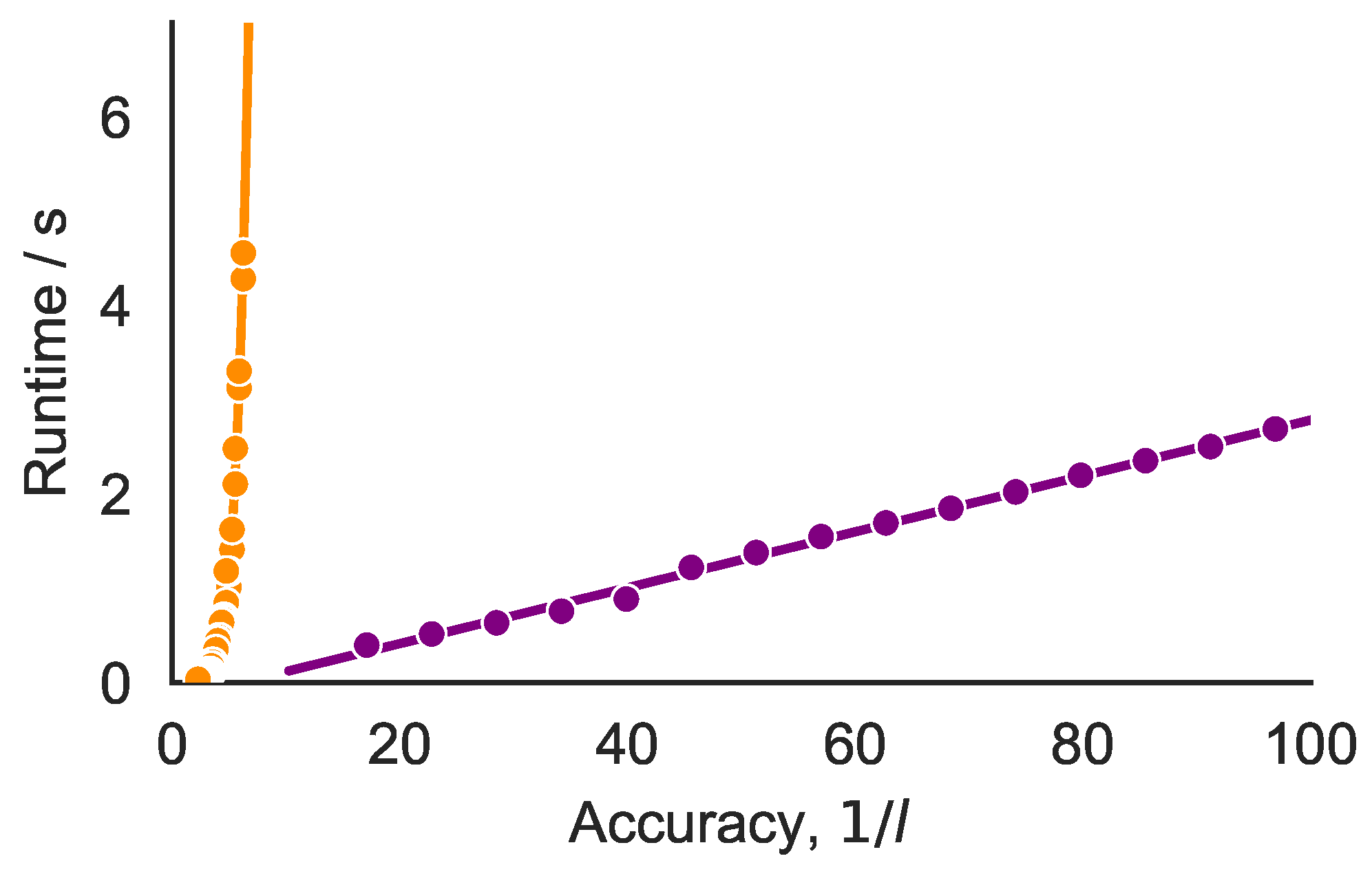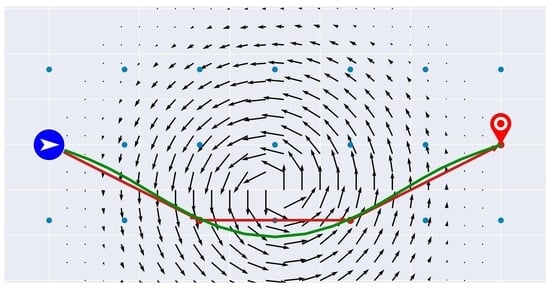A Discrete-Continuous Algorithm for Free Flight Planning
Abstract
:1. Introduction
2. Materials and Methods
2.1. Free Flight Planning
2.2. Continuous Approach: Optimal Control
2.2.1. Optimality Conditions
2.2.2. Collocation Discretization
2.2.3. Discretization Error
2.2.4. Newton-KKT Solver
2.2.5. Time Complexity
2.3. Discrete Approach: Shortest Paths in Airway Networks
2.3.1. Graph Construction
- 1.
- containment:
- 2.
- vertex density:
- 3.
- arc density: .
2.3.2. Discretization Error
2.3.3. Shortest Path Algorithm
2.3.4. Time Complexity
2.3.5. Graph Structure
2.4. DisCOptER Algorithm
| Algorithm 1: DisCOptER algorithm |
| Input: , , , Output: approximate solution of (1) with error of order , respectively
|
2.4.1. Initialization
2.4.2. Complexity
3. Results
3.1. Test Problems
3.2. Computational Complexity
3.3. Minimum Graph Requirements
3.4. Optimal Crossover Point
3.5. Computational Complexity
4. Conclusions
Author Contributions
Funding
Conflicts of Interest
References
- Stojković, S.E.K.S.S.A.G.; Stojković, M. Quantitative Problem Solving Methods in the Airline Industry; Springer: Berlin/Heidelberg, Germany, 2011; Chapter 6—Operations; pp. 283–383. [Google Scholar]
- Airbus Industries. Getting to Grips with Fuel Economy. Issue 4. 2004. Available online: https://ansperformance.eu/library/airbus-fuel-economy.pdf (accessed on 24 December 2020).
- Radio Technical Commission for Aeronautics. Final Report of RTCA Task Force 3 Free Flight Implementation; RTCA: Washington, DC, USA, 1995. [Google Scholar]
- Jelinek, F.; Carlier, S.; Smith, J.; Quesne, A. The EUR RVSM Implementation ProjectEnvironmental Benefit AnalysisEEC/ENV/ 2002/008. Technical Report. 2003. Available online: https://www.eurocontrol.int/eec/gallery/content/public/document/eec/report/2002/023_RVSM_Implementation_Project.pdf (accessed on 24 December 2020).
- Delling, D.; Wagner, D. Time-Dependent Route Planning. In Robust and Online Large-Scale Optimization: Models and Techniques for Transportation Systems; Ahuja, R.K., Möhring, R.H., Zaroliagis, C.D., Eds.; Springer: Berlin/Heidelberg, Germany, 2009; pp. 207–230. [Google Scholar] [CrossRef] [Green Version]
- Bast, H.; Delling, D.; Goldberg, A.; Müller-Hannemann, M.; Pajor, T.; Sanders, P.; Wagner, D.; Werneck, R.F. Route Planning in Transportation Networks. 2015. Available online: https://arxiv.org/pdf/1504.05140.pdf (accessed on 24 December 2020).
- Zis, T.P.; Psaraftis, H.N.; Ding, L. Ship weather routing: A taxonomy and survey. Ocean Eng. 2020, 213, 107697. [Google Scholar] [CrossRef]
- Yang, L.; Qi, J.; Song, D.; Xiao, J.; Han, J.; Xia, Y. Survey of Robot 3D Path Planning Algorithms. J. Control Sci. Eng. 2016, 2016, 1687–5249. [Google Scholar] [CrossRef] [Green Version]
- Blanco, M.; Borndörfer, R.; Hoang, N.D.; De las Casas, A.K.P.M.; Schlechte, T.; Schlobach, S. Cost projection methods for the shortest path problem with crossing costs. In Proceedings of the 17th Workshop on Algorithmic Approaches for Transportation Modelling, Optimization, and Systems (ATMOS 2017), Vienna, Austria, 7–8 September 2017; Volume 59. [Google Scholar]
- Blanco, M.; Borndörfer, R.; Hoang, N.D.; Kaier, A.; Schienle, A.; Schlechte, T.; Schlobach, S. Solving time dependent shortest path problems on airway networks using super-optimal wind. In Proceedings of the 16th Workshop on Algorithmic Approaches for Transportation Modelling, Optimization, and Systems (ATMOS 2016), Aarhus, Denmark, 25 August 2016. Schloss Dagstuhl-Leibniz-Zentrum für Informatik. [Google Scholar]
- Larsen, K.; Knudsen, A.; Chiarandini, M. Constraint handling in flight planning. In Principles and Practice of Constraint Programming; Lecture Notes in Computer Science; Beck, J., Ed.; Springer: Cham, Switzerland, 2017; Volume 10416, pp. 354–369. [Google Scholar]
- Marchidan, A.; Bakolas, E. Numerical Techniques for Minimum-Time Routing on a Sphere with Realistic Winds. Am. Inst. Aeronaut. Astronaut. 2016, 39, 188–193. [Google Scholar] [CrossRef] [Green Version]
- Jardin, M.R.; Bryson, A.E. Methods for computing minimum-time paths in strong winds. J. Guid. Control Dyn. 2012, 35, 165–171. [Google Scholar] [CrossRef]
- McDonald, J.A.; Zhao, Y. Time benefits of free-flight for a commercial aircraft. In Proceedings of the AIAA Guidance Navigation & Control Conference, Dever, CO, USA, 14–17 August 2000. [Google Scholar]
- Von Stryk, O.; Bulirsch, R. Direct and indirect methods for trajectory optimization. Ann. Oper. Res. 1992, 37, 357–373. [Google Scholar] [CrossRef]
- Betts, J.; Cramer, E. Application of direct transcription to commercial aircraft trajectory optimization. J. Guid. Contr. Dyn. 1995, 18, 151–159. [Google Scholar] [CrossRef]
- García-Heras, J.; Soler, M.; Sáez, F.J. A Comparison of Optimal Control Methods for Minimum Fuel Cruise at Constant Altitude and Course with Fixed Arrival Time. Procedia Eng. 2014, 80, 231–244. [Google Scholar] [CrossRef] [Green Version]
- Diedam, H.; Sager, S. Global optimal control with the direct multiple shooting method. Optim. Control Appl. Meth. 2017, 39, 1–22. [Google Scholar] [CrossRef]
- Sager, S.; Reinelt, G.; Bock, H. Direct Methods with Maximal Lower Bound for Mixed-Integer Optimal Control Problems. Math. Program. 2009, 118, 109–149. [Google Scholar] [CrossRef]
- Rao, A. A Survey of Numerical Methods for Optimal Control. Adv. Astronaut. Sci. 2010, 135, 497–528. [Google Scholar]
- Bonami, P.; Olivares, A.; Soler, M.; Staffetti, E. Multiphase mixed-integer optimal control approach to aircraft trajectory optimization. J. Guid. Control Dyn. 2013, 36, 1267–1277. [Google Scholar] [CrossRef] [Green Version]
- Moreno, L.; Fügenschuh, A.; Kaier, A.; Schlobach, S. A Nonlinear Model for Vertical Free-Flight Trajectory Planning. In Operations Research Proceedings; Springer: Cham, Switzerland, 2018; pp. 445–450. [Google Scholar] [CrossRef]
- Zermelo, E. Über das Navigationsproblem bei ruhender oder veränderlicher Windverteilung. ZAMM Z. Angew. Math. Mech. 1931, 11, 114–124. [Google Scholar] [CrossRef]
- Maurer, H.; Zowe, J. First and second-order necessary and sufficient optimality conditions for infinite-dimensional programming problems. Math. Program. 1979, 16, 98–110. [Google Scholar] [CrossRef]
- Pontrjagin, L.; Boltyansky, V.; Gamkrelidze, V.; Mischenko, E. Mathematical Theory of Optimal Processes; Wiley-Interscience: New York, NY, USA, 1962. [Google Scholar]
- Betts, J.T. Survey of Numerical Methods for Trajectory Optimization. J. Guid. Control. Dyn. 1998, 21, 193–207. [Google Scholar] [CrossRef]
- Hargraves, C.; Paris, S. Direct trajectory optimization using nonlinear programming and collocation. J. Guid. Control Dyn. 1987, 10, 338–342. [Google Scholar] [CrossRef]
- Fahroo, F.; Ross, I.M. Direct Trajectory Optimization by a Chebyshev Pseudospectral Method. J. Guid. Control Dyn. 2002, 25, 160–166. [Google Scholar] [CrossRef] [Green Version]
- Ascher, U.; Mattheij, R.; Russell, R. Numerical Solution of Boundary Value Problems for Ordinary Differential Equations; Prentice Hall: Upper Saddle River, NJ, USA, 1988. [Google Scholar]
- Hagelauer, P.; Mora-Camino, F. A soft dynamic programming approach for on-line aircraft 4D-trajectory optimization. Eur. J. Oper. Res. 1998, 107, 87–95. [Google Scholar] [CrossRef] [Green Version]
- Steihaug, T. The conjugate gradient method and trust regions in large scale optimization. SIAM J. Numer. Anal. 1983, 20, 626–637. [Google Scholar] [CrossRef] [Green Version]
- Toint, P. Towards an efficient sparsity exploiting Newton method for minimization. In Sparse Matrices and Their Use; Duff, I., Ed.; Academic Press: Cambridge, MA, USA, 1981; pp. 57–88. [Google Scholar]
- Weiser, M.; Deuflhard, P.; Erdmann, B. Affine conjugate adaptive Newton methods for nonlinear elastomechanics. Optim. Meth. Softw. 2007, 22, 413–431. [Google Scholar] [CrossRef]
- Deuflhard, P.; Bornemann, F. Scientific Computing with Ordinary Differential Equations, 2nd ed.; Texts in Applied Mathematics; Springer: New York, NY, USA, 2002; Volume 42. [Google Scholar]
- Becker, R.; Kapp, H.; Rannacher, R. Adaptive finite element methods for optimal control of partial differential equations: Basic concepts. SIAM J. Control Optim. 2000, 39, 113–132. [Google Scholar] [CrossRef] [Green Version]
- Weiser, M. On goal-oriented adaptivity for elliptic optimal control problems. Optim. Meth. Softw. 2013, 28, 969–992. [Google Scholar] [CrossRef]
- Deuflhard, P. Newton Methods for Nonlinear Problems. Affine Invariance and Adaptive Algorithms; Computational Mathematics; Springer: New York, NY, USA, 2004; Volume 35. [Google Scholar]
- Weiser, M.; Schiela, A.; Deuflhard, P. Asymptotic Mesh Independence of Newton’s Method Revisited. SIAM J. Numer. Anal. 2005, 42, 1830–1845. [Google Scholar] [CrossRef] [Green Version]
- Karaman, S.; Frazzoli, E. Sampling-based algorithms for optimal motion planning. Int. J. Robot. Res. 2011, 30, 846–894. [Google Scholar] [CrossRef]
- Borndörfer, R.; Danecker, F.; Weiser, M. Error Bounds for Free Flight Planning with Locally Connected Airway Networks; Technical Report; Zuse Institute Berlin: Berlin, Germany, in preparation.
- Junge, O.; Osinga, H. A set oriented approach to global optimal control. ESAIM: Contr. Opt. Calc. Var. 2004, 10, 259–270. [Google Scholar] [CrossRef]
- Karatas, T.; Bullo, F. Randomized searches and nonlinear programming in trajectory planning. In Proceedings of the 40th IEEE Conference on Decision and Control (Cat. No.01CH37228), Orlando, FL, USA, 4–7 December 2001; Volume 5, pp. 5032–5037. [Google Scholar] [CrossRef]
- Bouffard, P.; Waslander, S. A Hybrid Randomized/Nonlinear Programming Technique For Small Aerial Vehicle Trajectory Planning in 3D. Plan. Percept. Navig. Intell. Veh. (PPNIV) 2009, 63, 2009. [Google Scholar]
- Brunner, M.; Brüggemann, B.; Schulz, D. Hierarchical Rough Terrain Motion Planning using an Optimal Sampling-Based Method. In Proceedings of the 2013 IEEE International Conference on Robotics and Automation, Karlsruhe, Germany, 6–10 May 2013. [Google Scholar] [CrossRef]
- Techy, L. Optimal navigation in planar time-varying flow: Zermelo’s problem revisited. Intell. Serv. Robot. 2011, 4, 271–283. [Google Scholar] [CrossRef]









Publisher’s Note: MDPI stays neutral with regard to jurisdictional claims in published maps and institutional affiliations. |
© 2020 by the authors. Licensee MDPI, Basel, Switzerland. This article is an open access article distributed under the terms and conditions of the Creative Commons Attribution (CC BY) license (http://creativecommons.org/licenses/by/4.0/).
Share and Cite
Borndörfer, R.; Danecker, F.; Weiser, M. A Discrete-Continuous Algorithm for Free Flight Planning. Algorithms 2021, 14, 4. https://0-doi-org.brum.beds.ac.uk/10.3390/a14010004
Borndörfer R, Danecker F, Weiser M. A Discrete-Continuous Algorithm for Free Flight Planning. Algorithms. 2021; 14(1):4. https://0-doi-org.brum.beds.ac.uk/10.3390/a14010004
Chicago/Turabian StyleBorndörfer, Ralf, Fabian Danecker, and Martin Weiser. 2021. "A Discrete-Continuous Algorithm for Free Flight Planning" Algorithms 14, no. 1: 4. https://0-doi-org.brum.beds.ac.uk/10.3390/a14010004





